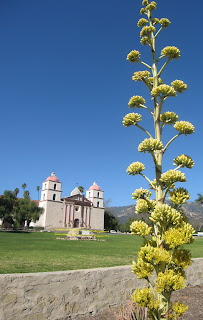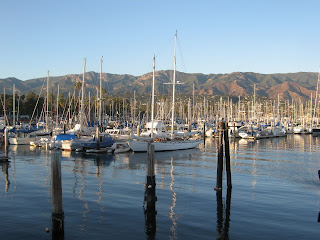Santa Barbara, California
We motor down the channel in the mid afternoon, in between the red and green buoys, dodging kayaks and day sailors to tie up at the fuel dock. The mountains and palm trees and sailboat masts are a backdrop to blue, cloudless skies. People are lazing on the beach on a Santa Barbara sun shining winter day.
“knock knock. Can I come aboard?” Harbor Patrol (control rather) at large.
“How are you today?” Cameron, a nice enough freckled-faced, khaki-clad chap asks as he comes below.
“We need to put red dye in the heads sir.” He proceeds.
What a bloody pain in the neck. As if we don’t know to use the harbor facilities when tied to the dock.
“Are you South African?” he asks and when I respond affirmative, expounds on his native country Kenya.
We talked and I hoped then to waylay him from dyeing up the second head.
“Do you have more than one head?” he politely asks in conclusion to conversation.
“Yes we do.” Russ responds as politely.
Into the 2nd head the red dye goes. Keep the water clean for the good of the sea and beach life. For the good of Russ who has to dive for the bronze oar lock he dropped into the deep, never to find again. Next request is to pump the dye into the holding tank. In doing so the jolly red dye spurts up like the Fountain of Trevi all over the cupboards, bulkheads, and head soles. Another broken head! Welcome to environmentally friendly Santa Barbara! Indeed it so is!
Every morning I wake up with a smile. Another 70 degree sunny day with clear blue winter skies and clean water! We take the 25 cent electric shuttle from Stearns Wharf up the main downtown State Street: past Yanonali, Ortega, Canon Perdido, Carrillo, Figueroa, Anapanu, Victoria (was she Spanish too), and Sola streets.
Street names conjure up images of panama hats, silver buckles, turquoise rings, scuffed cowboy boots, dusty streets, and bronze skins of yesterday. It is not difficult to imagine Santa Barbara a part of long ago Mexico. The climate, flora, and flavor linger.

The 25 cent downtown waterfront electric shuttle, leaves from Stearn’s Wharf
Last stop!” the bus driver calls.
We follow the direction the driver gives to get to the Old Mission: through Alameda Park, where Russ climbs an orange tree to pick four oranges. He gives two away to two women who stare in disbelief. They think twice, and then gingerly accept.
Russ climbs this orange tree to pick 4 oranges. He’s not in the tree yet
"Partners in crime!” he says laughingly.
The women look at each other guiltily and slowly smile.“They were giving away limes at a store the other day.” one of the women ventured the news as they parted ways.
'Tis the season of citrus I surmise. We eat the oranges on the spot. A bit sour. Our mouths pucker up. I feel alive in the Golden State. Russ plucks a twig of rosemary, squeezes it, and passes it to me to savor the sweet, sharp, pungent oil. He is thinking grilled lamb chops!

Russ pinches rosemary to take in the pungent scent of oil

This gorgeous flower looks heat stroked

Red hot poker cacti for want of a name

Leaning tower cacti for want of a name

Prickly pear cacti
We continue past old neighborhoods with pricey homes in established gardens: trimmed bougainvillea hedges, blooming cacti, and prickly pears.There on the hill in the sunlight stands the Old California Mission.
The Old California Mission stands on the hill to tell the story of change
Fray Junipero Serra, who founded the California Mission, looks on
Fray Junipero Serra (1713-1784) stands sculptured in bronze, holding a staff—founder of the California Mission. He looks out across the three-tier water fountain, crowned by a live seagull, across the clothes washing basin (lavanderia) built by the Chumash Indian artisans in 1818.
The lavanderia is a complex aqueduct system with a carved bear’s head at the north spout and a mountain lion head at the south spout. It was the original mission laundry where the Indians soaped and lathered the washing on the sloping sides, and rinsed them in the center pool.
The long red-tiled roof, stucco walls, symmetrical arches, wooden-eves and planked porch ceilings, and tiled floors join the church with two bell towers. The Mission lies silent in religious history: a place of teaching, of listening, of counseling, of worship. I stand still and drink in this snapshot of what used to be Mexico: the cacti in full bloom stand guard to change. I close my eyes to sense time gone by.

Red-tiled roof, stucco walls, symmetrical arches join the church: see reflection

Wooden eves and red tiled floors of the mission porch: cooling, simple, solemn

Beautiful blooming cacti are forefront to a single arch of the mission’s wing
Now back on State Street we fast forward to current day Santa Barbara. Affluence is on parade. Experience it, see it, taste it, find it the city guidebook iterates. The well heeled walk the length of the pedestrian-friendly street: pretty packages in hand, pencil thin jeans, golden high heels, Marilyn Monroe sun glasses, ruby lipstick. Perfumed.
Tucked into the decadence of the street is a hint of negative economic impact with some stores closing down and some already closed down. Empty spaces bookmarked by upscale markets.
There are 2000 homeless in Santa Barbara. On virtually every bench thoughtfully placed between the blossom trees and beds of Bird of Paradise, they sit. Their backpacks or wheelies are neatly parked besides them. Jackets and bedrolls folded. They are polite in asking for help. A man strokes his beard, combed for the day in the sun. They keep their troubles wrapped. They read. Smile. Portray a flower offering at their feet. Their signs say: Every little thing helps.
Outside Ralphs, the main grocery chain store, a middle-aged Mexican sits in the sun on a chair at a public table. He is a worker, perhaps at the hospital. He pulls out his homemade lunch in two Tupperware containers: one has chili sauce. The other is choc full with chicken thighs and meat. He uses his hands to neatly wrap the chicken and meat in a tortilla and dips it in the chili sauce. He relishes every morsel, wiping his hands on a paper towel, intermittently licking his fingers. A Stetson shades his ruddy Spanish face.
We transcend the steep class gaps. The 2009 International Film Festival is on at theatres on State Street. There are films by Santa Barbara filmmakers, diverse and issue-driven films, nature to the max films, Eastern European films. Directors and producers are in town. Stars like Penelope Cruz (Vicky, Cristina Barcelona), Mickey Rourke (The Wrestler), and Richard Jenkins (Burn after Reading) cruise the red carpet at the Arlington. They are being recognized. After all we are only 90 miles from Hollywood!
I take in a heaping tablespoon of mostly issue-driven films in two days. Johnny Cash at Folsom Prison: depicts Johnny’s involvement in the lives of prisoners. It centers on Glen Sherley, a prisoner inspired and encouraged by Cash, but whose failure gives insight into Cash’s legacy.
Pirate for the Sea: The Canadian, Paul Watson, captain of the Farley Mowatt, a modern day eco hero and militant Sea Shepherd conservationist confronts whalers and illegal fishermen in Antarctica and Costa Rica, including those who club to death soft white, wide-eyed baby seals on the ice fields of Eastern Canada.
Yes Madam, Sir: Portrays Kerin Bedi, India’s fist and highest-ranking female police officer who fought corruption and is known as a modern-day Gandhi.
Waveriders: A cinematic poem to the diverse culture of Irish surfing: Breathtakingly beautiful, inspiring, and educational. (“I want to go to Ireland”, Sarah, my gorgeous surfer daughter—now nursing student—says as I tell her about surfers riding the pipeline of high green, cold waves in the Atlantic.)
I come out from the theatre into the sunlight and capture the street for you:

The Granada Theatre as winter backdrop to State Street

Oncoming vintage car framed by State Street blossoms and Bird of Paradise

In 1876 a visiting sailor gave the seed of this Moreton Bay Fig tree to a young woman, who planted it. The Australian immigrant tree is now the largest of its kind in North America. A year after the girl left town, it was transplanted from State Street to its present side-street location by her friend.
A 1997 measurement is as follows: 41 ½ feet circumference 4 ½ feet above ground; average crown spread 176 feet; and total height 80 ft. Awesome to the eye.
Russ rides his bike to Goleta, through the wealthy neighborhoods with manicured lawns, to where he once lived. He reveled in memories of olden days. One of which was riding the ice cream van as a side-kick, bell ringing. His job was to spray barking dogs with what he thought was water. But the ice-cream man had mixed ammonia with the water he now realized. For this he got a free ice-cream. Smile.
“The best ride in a long time!” he says as he pushes his bike down the slipway. He had already gotten reprimanded for riding there by the Harbor Patrol (control).
“Next time it’s a $90 dollar fine the female cop warned with a friendly smile.”
I walk alone along the breakwater; boulders on either side of me—a railroad trestle at center. I look over the spit lined with pelicans across to Stearns Wharf. The bright red-hulled Alan-T returns through the red and green buoys after a day of channel dredging; a class of small sailboats race in a light wind like water ballerinas, they gracefully make their turns; a pelican rests on a breakwater rock, delicate patterned feathers in place; kelp is flattened fossil-like in the low-tide sand; the sun glistens on the water.

I see Zulu’s bow peeking out at the end tie. The masts of hundreds of moored sailboats are cast against the mountain backdrop. The waves crash gently against the breakwater. They lap up the curved beach. It is time to leave.
We cast off Zulu’s lines, say goodbye to characters who fleetingly crossed our paths, and anchor out off Montecita on a rolling swell. Fray Junipero Serra still looks down across the lavanderia to the rose gardens and grape vines; the well heeled still sip their wine at chic sidewalk restaurants; those without homes still gesture through telling eyes that every little thing helps; the Mexican worker still dips his meat in chili sauce at the public table; the films play on; the Harbor Patrol still looks after the environment, and the Moreton Bay Fig trees still grow tall, the oranges still ripen, and the rosemary bushes still hold their pungent oils until time forever more brings change.
For now the 1- or 2- or 4- or 8-million-dollar homes nestled in the purple-brown mountain folds are out of reach. The lights on the oil rigs shine. Sunlight succumbs to night. Slowly I climb down the companion way, turning my head one more time to shore, then close the hatch on Santa Barbara sun shining winter days.


















No comments:
Post a Comment